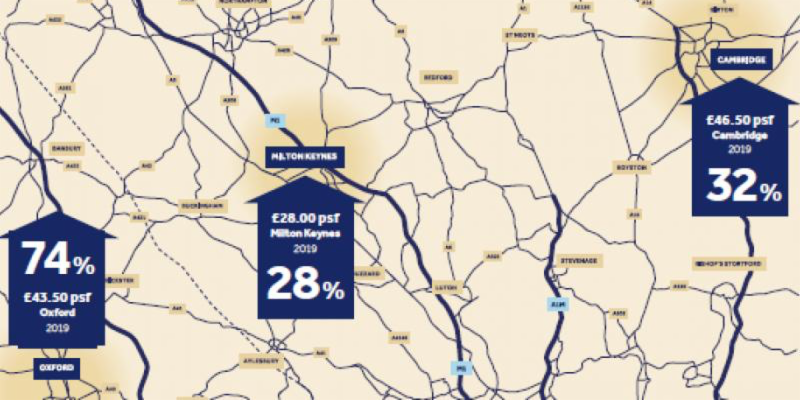New Bidwells research has revealed that up to 20 million sq ft of new lab and office space will be required in the Oxford-Cambridge Arc within the next two decades to keep pace with soaring demand, twice the volume of the previous 20 years.
The new report, ‘Oxford-Cambridge Arc Beyond the Covid-19 Crisis’ from Bidwells, also estimates that the Arc will represent almost 11 percent of UK GVA by 2050, up from 6 percent today, equivalent to £100bn a year.
However, the property consultancy has warned that a lack of new development and long-term strategic planning from Government is threatening to dampen investors’ appetite to invest in the region.
The Arc’s knowledge-based economy, which has a critical mass in Oxford and Cambridge, complemented by a fast-growing distribution sector along the M1 corridor, is crucial to UK plc’s role as a global exporter of innovation.
But rising lab and office rents, caused by a mismatch between supply and demand and a lack of infrastructure investment, is threatening to stall the rapid growth of the region by pricing out businesses and talent.
In the last five years, rents in Oxford, Cambridge and Milton Keynes have skyrocketed by 74 percent, 32 percent and 28 percent respectively. In Oxford, prices have reached historic highs of £46.50 per sq ft, putting rents in the same bracket as those in Zone 2 in Central London.
Since 2016, when the National Infrastructure Commission’s recommendations for maximising the potential of the Arc were published, decision making has been slow, exacerbated by ongoing political uncertainty associated with Brexit, and more recently by Covid-19.
To overcome these challenges, Bidwells is urging ministers to create a long-term strategic vision for the Arc. This will make the delivery of vital infrastructure improvements, which are deemed essential by local businesses to their ability to attract and retain talent, easier and quicker. The property consultancy argues that in order to capture the potential of the Arc, the science and tech sectors must be provided with the necessary facilities and infrastructure to scale-up.
The region’s high-growth core, where economic output rose by 5.4 % over the five years to 2018, compared to the national average of 3.7 %, has the ability to create vital, highly skilled employment opportunities.
In 2018, the number of people working in the Scientific & Technical sector across the Arc rose by 6.1%. In Cambridge, home to giants such as Amazon and Microsoft, this figure rose to 27 %, an addition of 8,000 new jobs.
As a global exporter of innovation, the Arc’s cluster of life sciences, research and development and tech industries will be crucial to the UK’s economic response to Covid-19.
Cambridge-based drug making giant AstraZeneca is working in partnership with Oxford University to develop a vaccine for the virus while Milton Keynes’ National Biosample Centre has been converted into the UK’s biggest coronavirus testing centre.
Sue Foxley, research director at Bidwells and author of the report, said:
There is huge potential to be captured in the Oxford-Cambridge Arc. But as our analysis shows, the core centres of Oxford, Cambridge and Milton Keynes do not have the capacity to solely accommodate all future growth potential.
“Leveraged private investment will be essential for the growth of the region and its economy, but a strategic approach from Government is needed to give investors the confidence to invest locally. Such an approach should drive the aspiration to capture, measure and track the economic and social contributions of innovation and invention that is so well illustrated by the Arc during the current global crisis.
Mike Derbyshire, head of planning at Bidwells, said:
The region is well positioned to capitalise on the government’s R&D agenda and should aspire to be an exemplar approach to innovation, infrastructure, social inclusiveness and natural capital.
“The Oxford-Cambridge Arc is the beating heart of UK innovation but a lack of development and investment threatens to price out new start-ups and reduce their ability to attract talent from the region’s world-leading higher education institutes. This, in addition to the glacial pace of policymaking at national and local level, unfortunately, puts the region’s long-term growth prospects in jeopardy.
Max Bryan, head of laboratory and office agency at Bidwells, said:
To maintain their pre-eminence in what is a global market of top research clusters, Cambridge and Oxford must continue delivering the new high quality, well-connected laboratory space that is so badly needed to service our now world-famous science and tech sector.
© Eastern Echo (powered by ukpropertyforums.com)
New Bidwells research has revealed that up to 20 million sq ft of new lab and office space will be required in the Oxford-Cambridge Arc within the next two decades to keep pace with soaring demand, twice the volume of the previous 20 years.
The new report, ‘Oxford-Cambridge Arc Beyond the Covid-19 Crisis’ from Bidwells, also estimates that the Arc will represent almost 11 percent of UK GVA by 2050, up from 6 percent today, equivalent to £100bn a year.
However, the property consultancy has warned that a lack of new development and long-term strategic planning from Government is threatening to dampen investors’ appetite to invest in the region.
The Arc’s knowledge-based economy, which has a critical mass in Oxford and Cambridge, complemented by a fast-growing distribution sector along the M1 corridor, is crucial to UK plc’s role as a global exporter of innovation.
But rising lab and office rents, caused by a mismatch between supply and demand and a lack of infrastructure investment, is threatening to stall the rapid growth of the region by pricing out businesses and talent.
In the last five years, rents in Oxford, Cambridge and Milton Keynes have skyrocketed by 74 percent, 32 percent and 28 percent respectively. In Oxford, prices have reached historic highs of £46.50 per sq ft, putting rents in the same bracket as those in Zone 2 in Central London.
Since 2016, when the National Infrastructure Commission’s recommendations for maximising the potential of the Arc were published, decision making has been slow, exacerbated by ongoing political uncertainty associated with Brexit, and more recently by Covid-19.
To overcome these challenges, Bidwells is urging ministers to create a long-term strategic vision for the Arc. This will make the delivery of vital infrastructure improvements, which are deemed essential by local businesses to their ability to attract and retain talent, easier and quicker. The property consultancy argues that in order to capture the potential of the Arc, the science and tech sectors must be provided with the necessary facilities and infrastructure to scale-up.
The region’s high-growth core, where economic output rose by 5.4 percent over the five years to 2018, compared to the national average of 3.7 percent, has the ability to create vital, highly skilled employment opportunities.
In 2018, the number of people working in the Scientific & Technical sector across the Arc rose by 6.1 percent. In Cambridge, home to giants such as Amazon and Microsoft, this figure rose to 27 percent, an addition of 8,000 new jobs.
As a global exporter of innovation, the Arc’s cluster of life sciences, research and development and tech industries will be crucial to the UK’s economic response to Covid-19.
Cambridge-based drug making giant AstraZeneca is working in partnership with Oxford University to develop a vaccine for the virus while Milton Keynes’ National Biosample Centre has been converted into the UK’s biggest coronavirus testing centre.
Sue Foxley, research director at Bidwells and author of the report, said:
There is huge potential to be captured in the Oxford-Cambridge Arc. But as our analysis shows, the core centres of Oxford, Cambridge and Milton Keynes do not have the capacity to solely accommodate all future growth potential.
“Leveraged private investment will be essential for the growth of the region and its economy, but a strategic approach from Government is needed to give investors the confidence to invest locally. Such an approach should drive the aspiration to capture, measure and track the economic and social contributions of innovation and invention that are so well illustrated by the Arc during the current global crisis.
Mike Derbyshire, head of planning at Bidwells, said:
The region is well positioned to capitalise on the government’s R&D agenda and should aspire to be an exemplar approach to innovation, infrastructure, social inclusiveness and natural capital.
“The Oxford-Cambridge Arc is the beating heart of UK innovation but a lack of development and investment threatens to price out new start-ups and reduce their ability to attract talent from the region’s world-leading higher education institutes. This, in addition to the glacial pace of policy making at national and local level, unfortunately puts the region’s long-term growth prospects in jeopardy.
Max Bryan, head of laboratory and office agency at Bidwells, said:
To maintain their pre-eminence in what is a global market of top research clusters, Cambridge and Oxford must continue delivering the new high quality, well-connected laboratory space that is so badly needed to service our now world-famous science and tech sector.
© Eastern Echo (powered by ukpropertyforums.com)











